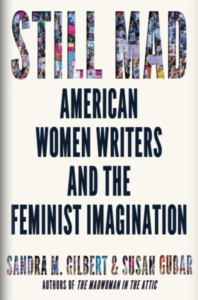
What We Can Learn from Feminist Rage
Sandra M. Gilbert and Susan Gubar on the Energizing Force of Anger
Those who can’t march, write. As many of our friends prepared to go on the January 21, 2017, Women’s March, we knew that, with our various disabilities, we weren’t physically able to join them. How could we stand in solidarity, we wondered? An answer to this question arrived a week before the massive protests in Washington, DC, and many cities around the globe, when we began collaborating on a book.
The passion then in the air recalled for us the intensity of the feminist movement in the seventies, a powerful social uprising that reflected a transformative political awakening for women and girls, and sometimes the men and boys around them. Looking back on that earlier time, the film critic Molly Haskell captured the sense of excitement: “We were rejecting the past, rejecting being circumscribed, rejecting the ways of our mothers. It was as if an entire landlocked race had climbed up a cliff and seen the vast wide sea for the first time. . . . Everything was possible.”
Of course, things were different in January 2017. What had seemed impossible—the defeat of a highly qualified woman candidate for the presidency by a boorish, utterly unqualified man—had not only become possible, it had happened. The countless worldwide protests were clearly fueled by feminism. If the women’s liberation movement of the seventies hadn’t had such far-reaching effects, the outcome of the election might not have seemed quite so scandalous, and the immediate need to protest might not have been so urgent. At the same time, though, even as the giant wave of protest mimicked the impassioned demonstrations of the seventies, it soon enough became obvious that this rebellion was inspired by despair. While the marchers of the seventies felt themselves to be advancing into a brave new world, the plaintiffs of 2017 were gazing at a fallen world, dominated by a corrupt figure both infantile and demonic.
To tell the story of what we consider the ongoing second wave of feminism, we have chosen representative women—poets, novelists, dramatists, singers, journalists, memoirists, theorists—who seemed especially charismatic to us. Taken together, they subvert the standard caricature of the women’s movement as white, middle-class, and elitist. We’ve also chosen to concentrate on North American literary women, although all our other books examine the transnational relationships of women writing in English. But the shock of the election of a nativist president led us to narrow our focus to feminisms in our own country. And the permeable borders between Canada and America have made several Canadian women writers especially important to the American reading public.
Because we are still mad, we seek to understand feminism’s past and present in order to strengthen its future.
Certainly, we could have picked other significant figures, but those we chose seemed to us to help keep things going while things were stirring, as the great nineteenth-century suffragist Sojourner Truth put it. We were drawn not only to the publications of notable women but also to their lives, which dramatize the problems flesh-and-blood women face as they make the personal political. There has been much misrepresentation and some trashing of feminism’s past, and maybe too much generalizing as well. We sought not to homogenize but to pay tribute to what the women’s movement contributed not only to our present opportunities but also to an even more liberated future.
One of the debates in which women continue to engage swirls around the issue of how many “waves” of feminism there have been in American history: some say three, some say more. But the problems faced by women and the strategies devised by feminists evolved continuously throughout the late twentieth century and the first two decades of the twenty-first century. Just as we can trace the development of the first wave of the women’s movement from the 1848 Seneca Falls Convention to the Nineteenth Amendment granting the right to vote in 1920, so we can conceptualize one second wave that grew from the nineteen fifties up to today: tremulous, tumultuous, tremendous, ongoing. With that perspective, we take to heart the fact that all of us are still in the midst of it, keeping things going while things are stirring.
To ensure future progress, we must all continue to contest, agitate, and advocate, for “if we wait till it is still,” Sojourner Truth cautioned, “it will take a great while to get it going again.” Sojourner Truth, who was “above eighty years old” when she spoke those words, believed that she was “kept here because something remains for me to do; I suppose I am yet to help to break the chain.” We two, we too, feel similarly.
*
Mantras of bygone days still ring in our ears: We’ve come a long way, professor! We’re shattering glass ceilings! We can have it all! We’re leaning in and the culture’s changing! But is the culture really changing? If it is, why are we and so many of our friends still mad? Mad as in the sense of enraged. Mad as in the sense of maddened, confused, or rebellious. Maybe if you come a long way, you encounter territorial backlash. Maybe if you shatter glass ceilings, you have to walk on broken glass. Maybe if you lean in, you topple over.
Four decades have gone by since we opened our first coauthored book, The Madwoman in the Attic, with the question “Is a pen a metaphorical penis?” We were attempting to examine the centuries-long identification of authority with masculinity in order to excavate female literary traditions. Now we find ourselves mulling over a related question as we seek to understand the gender implications of American politics. In this presumably more liberated moment, when quite a few women have come forward as serious candidates for the presidency, we nevertheless find ourselves asking, Must the president have a penis?
So far, all our presidential elections have suggested as much. In 2016, an unqualified, misogynistic television personality defeated a highly qualified, ambitious female politician in the Electoral College, although she won the popular vote by a margin of three million. But even more recently, a trio of vigorous, experienced women senators—Kamala Harris, Amy Klobuchar, Elizabeth Warren—dropped out of the Democratic primaries, leaving two elderly men standing, 78-year-old Bernie Sanders and 77-year-old Joe Biden; and finally, Joe Biden became the candidate. One factor that was put forward to explain these latest defeats? Electability. No “mere” woman, it was thought, could defeat the rabble-rousing, nearly psychotic Donald J. Trump, nor would a self-declared socialist like Sanders be able to trounce the monster. In a sense, however, Trump trounced himself with his bungled response to the pandemic that spread as the campaigns continued, so that the more empathic and rational Biden triumphed.
As Trump’s bullying “lock her up” campaign against Clinton foretold, his term in office triggered an explosion of chaos, falsehood, and corruption that shattered all political norms, and its disorder peaked with his incompetent handling of COVID-19. At first denying the danger of the novel coronavirus, then promising that it was under his control, the president failed to organize the provision of testing, contact tracing, protective equipment, ventilators, national stay-at-home orders, and other medical necessities. While at some press conferences he boasted that only he could dictate the sheltering-in-place prescribed by epidemiologists and ordered by governors, at other briefings he claimed that the governors were in charge and he took no responsibility.
Toward the end of the second month of the viral rampage, Trump began, as Governor Jay Inslee put it, “fomenting domestic rebellion,” tweeting out “LIBERATE MINNESOTA!” “LIBERATE MICHIGAN!” “LIBERATE VIRGINIA” in support of alt-right demonstrators protesting against the social distancing orders issued by his own government and adding ominously, “and save your great 2nd amendment [the right to bear arms]. It is under siege!” Was he in fact fomenting armed insurrection? And did he seriously mean, a week or two later, to suggest that Americans should try to cure themselves of COVID-19 by injecting disinfectant into their bodies—for example, Lysol? Then he ordered the military to use flash-bang explosives, tear gas, rubber bullets, and helicopters against peaceful Black Lives Matter protesters in Washington, DC (so he could stage a photo-op while holding the Bible upside down).
When he was defeated by Joe Biden in the election of 2020, he refused to concede, firing advisers who tried to tell him he had lost and repeatedly posting such tweets as “NO WAY WE LOST THIS ELECTION” and “We won Michigan by a lot!” Peter Baker of the New York Times compared him to a mad king at the end of a Shakespearean tragedy.
Of course, in a traditional democracy, where each citizen has one vote and no electoral college obstructs the will of the majority, Hillary Clinton, the first woman to run for president under the aegis of a major political party, would actually have won the election. An educated and experienced politician, she would surely not govern by tweet, not deny or evade the existence of a major medical threat, not foment rebellion among the citizens of her land or counsel people to ingest Lysol or enlist the military against civil rights protesters. In a counterhistory paralleling the anarchic narrative in which Americans became enmeshed, we can suppose that President Hillary Clinton would have run an orderly administration, no doubt with flaws and dissenters—but a stable government, much like, say, that of Angela Merkel.
After the 2016 election, second-wave feminism had evidently both triumphed and failed.
Like us, this hypothetical president is the product of the seventies, and arguably it was seventies feminism that facilitated her unprecedented rise as the first female candidate for the presidency of the United States sponsored by a major party. She is also a paradigm of the seventies—a dramatic exemplar of the far-reaching possibilities of the women’s liberation movement and at the same time a model victim of the backlash that the movement continually had to confront. During the seventies, Clinton earned a law degree, struggled to continue using the name Rodham, and determined that she didn’t want to “stay home and bake cookies” because she wasn’t “just some little woman standing by my man.” As First Lady, she famously declared that “human rights are women’s rights; and women’s rights are human rights.” After her husband left office, she established a notable record as the first First Lady elected to public office—the first woman senator from New York—and then as a highly praised secretary of state.
The historical transformations that rocketed Clinton into national politics were precisely those that propelled our generation into the professions. These upheavals would become the subject of intellectual inquiries that changed our lives as well as the lives and works of many of our contemporaries. As if in acknowledgment of this point and also to evoke the suffragists of the first wave of feminism, who wore white to proclaim allegiance to their cause, Clinton sported a white pantsuit when she accepted the Democratic nomination.
After the 2016 election, second-wave feminism had evidently both triumphed and failed. As the extraordinary Women’s March on Washington of January 21, 2017, revealed, many were angry at the failure, but also puzzled by how it could have happened during a time of so many achievements. We were baffled too. The why of this book? Because we are still mad, we seek to understand feminism’s past and present in order to strengthen its future. The 2016 election, which dramatized feminism’s successes but also its failures, proves that women and men must learn over and over again what our generation started to learn and teach in the seventies and what we began learning during the semester we were teaching the material that would become The Madwoman in the Attic. Its aftermath also confirms that feminists today have begun channeling the rebellious rage of the madwoman we studied, a female figure silenced by patriarchal structures that have proven to be shockingly obdurate.
__________________________________

Excerpted from Still Mad: American Women Writers and the Feminist Imagination, by Sandra M. Gilbert & Susan Gubar, to be published by W. W. Norton. Copyright © 2021 by Sandra M. Gilbert & Susan Gubar. All rights reserved.
Sandra M. Gilbert and Susan Gubar
Sandra M. Gilbert is a distinguished literary critic, poet, and professor emerita at the University of California, Davis. The author, most recently, of Judgment Day: Poems, she lives in Berkeley, California. Susan Gubar is an acclaimed memoirist, literary critic, and professor emerita at Indiana University. The author, most recently, of Late-Life Love: A Memoir, she lives in Bloomington, Indiana. Gubar is the co-author, with Sandra M. Gilbert, of The Madwoman in the Attic, a finalist for the Pulitzer Prize, and co-editor of The Norton Anthology of Literature by Women, among other volumes. In 2012, they were awarded the Ivan Sandrof Lifetime Achievement Award by the National Book Critics Circle.



















